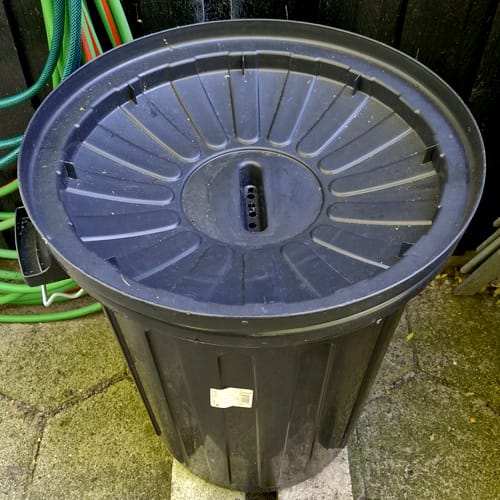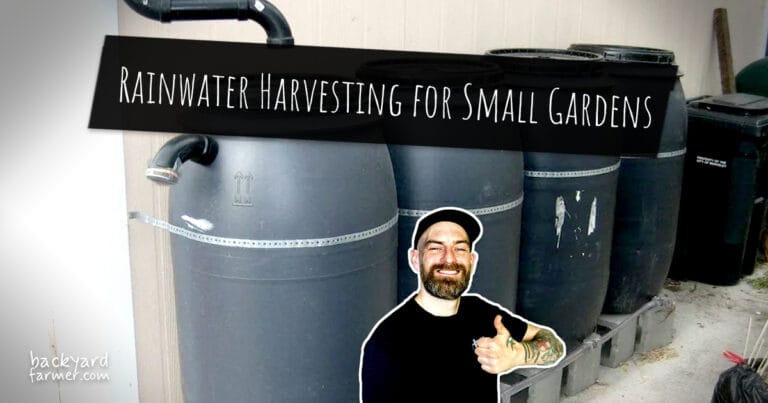Table of contents
Why Collect Rainwater? (Cost Savings + Sustainability)
If you garden in the UK, chances are you’ve looked at your water bill after a dry spell and wondered if there’s a smarter option. Rainwater harvesting UK offers exactly that—a simple, eco‑friendly way to collect rainwater and reuse it in your garden. By capturing roof run‑off and storing it in a water butt, you can create a reliable, sustainable water source for everyday gardening tasks.
Key Benefits of Rainwater Harvesting
- Save money – Every watering can filled from your butt is one less litre taken from the mains supply.
- Healthier plants – Stored rainwater is naturally soft and free from chlorine or added salts, making it perfect for vegetables, herbs, and houseplants.
- Sustainable living – By reducing mains usage and easing pressure on storm drains, you lower your environmental impact and build a more resilient garden.
Small Gardens Can Benefit Too
The best part? You don’t need a farm or a large property to get started. With a simple DIY water butt system, even a compact patio, balcony, or small domestic garden can benefit from rainwater collection.
In this guide, we’ll cover:
- How to set up a rainwater harvesting system cheaply.
- How to collect rainwater safely with the right filters and covers.
- How to integrate rainwater harvesting into your other sustainable gardening projects.
✅ Key takeaway: Rainwater harvesting is cost‑effective, eco‑friendly, and achievable in even the smallest UK gardens.
What You Need for a DIY Water Butt System
Setting up a DIY rainwater harvesting system UK doesn’t have to be expensive. Most of the essentials can be picked up from garden centres, DIY stores, or even sourced for free if you’re happy to repurpose. Below is the core kit for a small domestic rainwater harvesting system:
Essential Equipment
- Water butt or rainwater tank – This is your main storage container. Pick a size that suits your space: slimline butts fit well on patios and balconies, while recycled barrels or larger rainwater storage tanks work best for bigger gardens.
- Downpipe diverter kit – A simple fitting that redirects water from your gutter into the butt. Many diverters also include a basic filter to trap leaves and grit.
- First-flush filter – Optional but useful. This device diverts the first, dirtiest flow of rainwater away, leaving cleaner water for your vegetables, herbs, and houseplants.
- Stand or base – Raising your butt boosts water pressure and makes filling cans easier. A DIY option is to build a sturdy base from reclaimed pallets (see our guide on [raised beds from pallets]).
- Overflow pipe – Ensures excess water drains away safely, protecting your foundations. You can direct it into another container, a soakaway, or even a flower bed.
If you’re building a stand for your water butt, check out our guide on where to find free pallets in the UK to source sturdy materials at no cost.
Quick Tip
💡 Start small. Begin with just a water butt and diverter. You can always upgrade later with extras like a first-flush filter or additional storage tanks. Even the most basic setup will help you collect rainwater safely, cut costs, and make your garden more sustainable.
Quick Tip
💡 Budget-friendly storage: While a bin won’t last as long as a purpose-built DIY water butt system or a larger rainwater storage tank, it’s still a practical way to collect rainwater safely. Perfect for allotments and small gardens where sustainable watering makes all the difference.
The Allotment Rainwater Hack: Low-Cost DIY Storage
Not every gardener wants to spend money on a purpose-built water butt, and on allotments, it’s often the simple, hands-on fixes that work best. One clever trick is to repurpose a plastic bin as a DIY rainwater harvesting system UK growers can trust. It’s a quick and affordable way to create a small domestic rainwater harvesting system without much effort.

How to Make It Work
- Drill small holes – Put a few holes in the centre of the lid so rainwater flows in while most leaves and debris stay out.
- Add a weight – Place a small weight on top to keep the lid from blowing away in strong winds.
- Set it anywhere – This setup is cheap, effective, and flexible. You can position these bins anywhere around your allotment plot or small garden.
Step-by-Step Installation Guide
Installing a DIY rainwater harvesting system UK is straightforward and doesn’t require specialist skills. With a few tools and a spare afternoon, you’ll be ready to collect rainwater safely before the next downpour.
How to Install Your Water Butt System
- Choose the location
Place your water butt near a downpipe for easy connection. Check the ground is level and strong enough to support the full weight of a filled rainwater storage tank. - Prepare the stand or base
Raise the butt on a stand or pallet base. This boosts water pressure, makes it easier to fill watering cans, and keeps the system stable. - Fit the downpipe diverter kit
Cut a short section from your downpipe at the recommended height (just above the butt). Install the diverter so rainwater flows directly into your container when it rains. - Add a first-flush filter (optional)
Connect a first-flush diverter between the downpipe and the butt if you want cleaner water. This redirects the first, dirtiest flow away, keeping your stored rainwater clear for vegetables, herbs, and compost tea. - Connect the overflow pipe
Ensure excess water drains safely—ideally into a flower bed, soakaway, or a second rainwater harvesting tank. - Secure and cover
Fit a tight lid to block debris, algae, and mosquitoes. Always double-check fittings are snug, watertight, and safe. - Test the system
Pour a bucket of water into the gutter or wait for the next rainfall. Confirm that water flows into the butt correctly and the overflow is working.
✅ Key takeaway: Once installed, you’ll have a reliable supply of free rainwater—perfect for compost bins, pallet raised beds, houseplants, and eco-friendly irrigation.
Safety & Legality of Rainwater Harvesting in the UK
Rainwater harvesting UK is fully legal, and it’s one of the easiest ways to make the most of free water from the sky. However, it’s worth knowing a few safety tips so you can collect rainwater safely while protecting both your home and your garden.
Roof Types and Safety
- Avoid hazardous materials – Never collect rainwater from roofs with asbestos, lead flashing, or old tar coatings. These can contaminate your water.
- Better roof choices – Modern slate, clay tile, and metal roofs are safe options for a small domestic rainwater harvesting system UK gardeners can trust.
Filters and Covers
- Keep it clean – Install a mesh filter or leaf guard at the gutter to reduce debris entering your system.
- Always use a lid – A secure lid on your butt or rainwater storage tank keeps out mosquitoes, reduces algae growth, and prevents accidents with children or pets.
- First-flush diverters – These divert the first, dirtiest flow of rainwater away, leaving you with cleaner water for vegetables, houseplants, and compost tea.
Legal Position in the UK
- Non-potable use only – Harvested rainwater should be used for gardening, washing cars, or flushing toilets. Do not use it for drinking, cooking, or bathing unless treated with specialist filtration and disinfection.
- Government guidance – The UK government actively supports sustainable practices, and rainwater harvesting is encouraged to help reduce demand on mains supply.
For official guidance, see the UK government’s rainwater harvesting regulatory position statement.
💡 Key takeaway: Treat harvested rainwater as a free, eco-friendly alternative to mains water in the garden. By adding basic filters and following simple precautions, you’ll keep your system safe, legal, and effective.
Using Rainwater in Your Garden and Home
Once your rainwater harvesting system UK is up and running, the fun part begins—actually putting that stored water to good use. Even a single water butt can make a big difference in a small domestic garden.
In the Garden
- Raised beds and borders – Rainwater is naturally softer than tap water, which means vegetables, herbs, and flowers absorb it more easily. It’s perfect for pallet-raised beds and eco-friendly planting.
- Compost tea and leachate dilution – Use harvested rainwater to activate compost tea or dilute leachate from compost bins. This creates a natural fertiliser that feeds plants gently without the risk of root burn.
- Greenhouses and polytunnels – Because rainfall can’t reach undercover crops, stored rainwater is the ideal backup supply for irrigation.
For Houseplants
- Indoor plants thrive – Many houseplants, especially those sensitive to lime or chlorine (like peace lilies or spider plants), prefer rainwater. Simply fill a watering can straight from your butt and use it indoors.
Around the Home
- Outdoor cleaning – Wash muddy boots, rinse garden tools, or even clean the car with harvested rainwater. Every bucket used saves mains water and helps reduce bills.
- Eco-friendly irrigation – Attach a hose or drip line to your water butt for low-cost irrigation in the summer. It’s efficient, sustainable, and saves you carrying heavy watering cans.
⚠️ Key tip: Don’t confuse rainwater with greywater. Rainwater falls fresh from the sky and is safe for garden use, while greywater (from sinks, baths, or washing machines) comes with extra risks. For more detail, see our eco cleaning guide.
Comparing Rainwater Diverters & Filters
When setting up a DIY rainwater harvesting system UK, the diverter and filter you choose can make all the difference. The best option depends on your budget, the size of your rainwater storage tank, and how much maintenance you want to handle.
Diverter and Filter Options
| Product | Price Range | Features | Best For |
|---|---|---|---|
| Basic Diverter Kit | £10–£20 | Simple downpipe fitting, channels water into the butt, no filtration | Beginners, small domestic rainwater harvesting systems |
| Diverter with Leaf Guard | £20–£35 | Mesh or guard blocks leaves and large debris | Gardens with trees nearby |
| First-Flush Diverter | £25–£40 | Redirects the first dirty flow of rainwater, keeps stored water cleaner | Cleaner water for houseplants and greenhouse use |
| Inline Filter + Diverter Kit | £40+ | Fine mesh filtration, durable, easy to clean | Gardeners who want low-maintenance, high-quality water |
Quick Tip
💡 Start simple. If you’re new to rainwater harvesting UK, a basic diverter kit is more than enough. You can always upgrade to a first-flush diverter or inline filter later—especially if you want to collect rainwater safely for indoor plants or compost tea.
FAQs on Rainwater Harvesting
Here are some of the most common questions people ask when setting up a rainwater harvesting system UK for their garden:
In most cases, yes. Rainwater from modern slate, tile, or metal roofs is safe for vegetables, herbs, and raised beds. Avoid collecting from asbestos or lead roofs, as these can leach harmful substances. To collect rainwater safely, always use a secure lid on your water butt or rainwater storage tank, and add a simple filter to block debris.
It depends on your roof size and local rainfall. A typical UK roof can collect thousands of litres per year. Even a single 200L butt in a small domestic rainwater harvesting system can fill several times during a wet season.
A basic DIY water butt system with a diverter can cost as little as £30–£50. Adding extras such as a first-flush diverter, inline filter, or multiple tanks may bring the cost closer to £100, but it’s still much cheaper than a professional underground installation.
No. Harvested rainwater should not be used for bathing, drinking, or cooking unless treated with advanced filtration and disinfection systems. For most gardeners, it’s best used for non-potable purposes such as irrigation, compost tea, outdoor cleaning, and even flushing toilets.
💡 Key tip: Think of rainwater harvesting as a way to access free, plant-friendly water that cuts bills and supports sustainability. It’s not a replacement for your indoor mains supply, but it’s a smart and practical upgrade for any UK garden.
Final Thoughts
Rainwater harvesting UK is one of the easiest and most effective ways to make your garden more sustainable. With just a water butt, a downpipe diverter, and a bit of DIY effort, you can reduce your water bill, keep your plants healthier, and cut down your environmental footprint.
Why It Works for Small Gardens
For small domestic rainwater harvesting systems, the advantages are clear:
- Low cost – A starter DIY water butt system can be set up for under £50.
- Eco-friendly – Rainwater is naturally soft and chemical-free, making it better for both plants and soil.
- Scalable – Start small with one butt and expand later with stands, filters, or extra rainwater storage tanks as your garden grows.
Combine with Other Eco Projects
Pair your rainwater harvesting setup with other sustainable projects:
- Compost bins for natural fertiliser.
- Raised beds from pallets for efficient and low-cost growing.
Together, these create a garden system that works with nature, not against it.
💡 Key takeaway: Rainwater harvesting doesn’t have to be complicated or costly. With a simple, small domestic system, you’ll enjoy free water on tap, healthier plants, and the satisfaction of gardening more sustainably.





